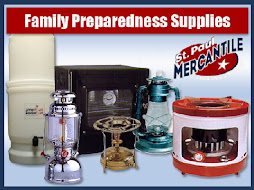There are a lot of kerosene stoves to choose from. Here is the link to my web page where all are displayed: http://www.stpaulmercantile.com/index.php?action=store&page=KeroseneStovesAndOven
I sell the Butterfly brand of kerosene cook stoves. They are made in Indonesia.
3 Types - You should first be aware that there are 3 types of stoves. 1) Brass Pressurized stoves (#2412), 2) Gravity fed wick stoves with fuel bottles (2413, 2418, 2419, 2415, 2417) that come in single, double and triple-burner models, and 3) Multi-Wick stoves that have 10-22 cotton wicks arranged in a circle. These wicks can be moved up and down to adjust the heat output of the stoves.
Brass Pressure Stove - Pressure stoves are in a category all their own. They do not have wicks, as they actually boil the fuel and burn the vapor. The burner assembly must be preheated by burning a couple teaspoons of denatured alcohol (available in a quart can at any hardware store). The flame from the alcohol heats the burner assembly for 20-30 seconds. When the alcohol is just about to go out, you start pumping the handle. Liquid kerosene from the tank enters the burner assembly and the first few drops turn to vapor, which is then ignited from the alcohol's flame. Once the flame has started, the heat from the flame keeps the burner assembly hot enough to continue to vaporize the rising liquid kerosene.
Pressure stoves are highly efficient, they produce the least fumes of any type of kerosene stove, and they disassemble for carrying in a backpack.
Gravity Fed Wick Stoves - these stoves have a fuel bottle with a spring-loaded cap on it. The bottle releases fuel into a fuel reservoir and the fuel then runs through a fuel rail to the burner(s). Each burner contains one woven fiberglass wick that is bent into a circle, about the size of a metal jar lid. The flame burns off the top edge of the wick. Worldwide, these are the most popular stoves sold. Many decades ago, these were sold in the USA by Sears and Montgomery Ward.
Each burner has a wire contraption that will keep small pots or skillets in place. It is shaped such that the optional oven will fit perfectly over the wire and will be held in place on top of the stove. Flame height adjustment is done by increasing or decreasing the amount of fuel that gets to the wick. It can take up to a minute for the flame adjustment to occur, as the wick must absorb extra fuel (if increasing the flame) or burn up the excess fuel (if decreasing the flame) before it adjusts to the new level of fuel delivery.
Multi Wick Stoves - These use multiple cotton wicks, arranged in a circle. All of the wicks can be moved up or down to increase/decrease the amount of heat from the stove. More wicks means more heat, so the entry level 10-wick stove produces about 7000 btus of heat, while the 22-wick stove produces 14,000 btus.
Recommendations - If you need something small and transportable, choose the brass pressure stove. For most people, the #2487 16-wick stove is going to be an excellent choice. It is hot enough to cook meals, it has an improved tank design over the 14-wick 2628, and it has the special wire top that works perfectly with the oven. For canning, the #2698 22-wick stove is the stove to buy. It has the highest heat output, and the largest cooking surface for holding your canner.
http://www.stpaulmercantile.com/index.php?action=store&page=KeroseneStovesAndOven
Friday, April 17, 2009
Subscribe to:
Post Comments (Atom)





With so many brands available in the market, it becomes quite confusing selecting the right brand.
ReplyDeleteSurvival Food
Where are all the butterfly stoves and oven?
ReplyDelete